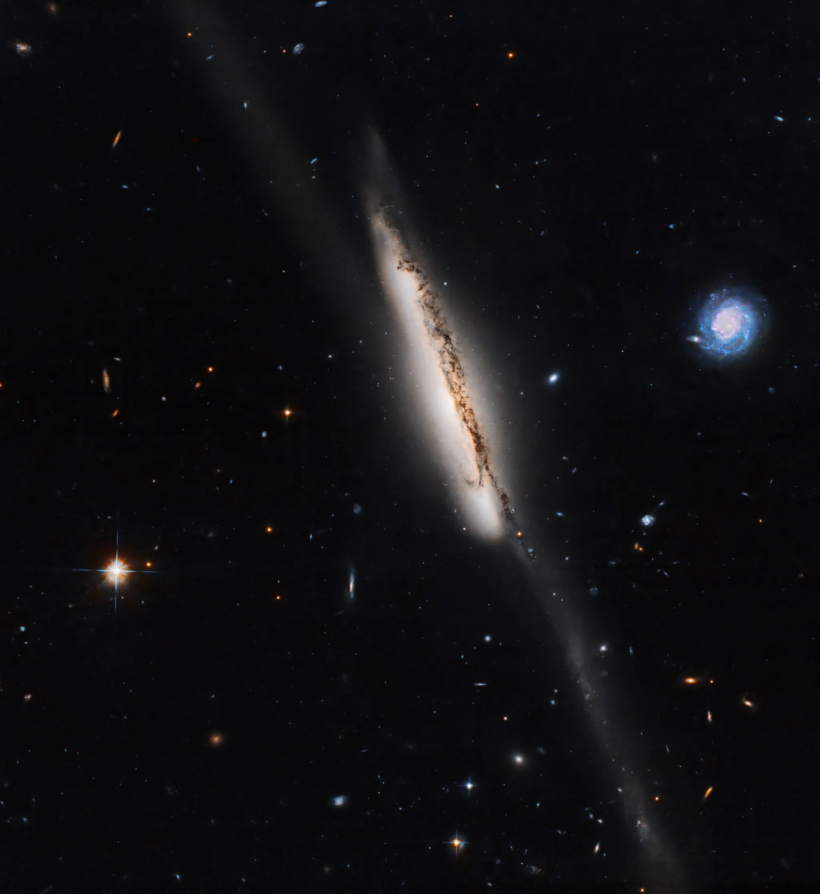NASA's Hubble Space Telescope has unveiled a breathtaking image capturing a faint bridge of stars in the galactic group known as Arp 295.
This cosmic spectacle features one of the galaxies from Arp 295, along with a bridge of stars and gas extending over 250,000 light-years between two galaxies.

NASA's Hubble Space Telescope captured a faint bridge of stars in a galactic group known as Arp 295. It features the 250,000-light-year-long bridge of stars and gas connecting two galaxies. Their proximity caused mutual gravity, giving rise to this cosmic streamer, according to NASA.
NASA on Cosmic Streamer
According to NASA, the formation of this cosmic streamer results from the mutual gravity between the galaxies as they pass close enough together. These interacting galaxies, known as Arp 295, consist of three spiral galaxies: Arp 295a, Arp 295b, and Arp 295c.
Arp 295a is the edge-on galaxy visible in the center of the image, while Arp 295c is the smaller and bluer face-on spiral to its right. On the other hand, Arp 295b is on the top left but not visible in the image.
The galaxies are situated approximately 270 million light-years away in the constellation Aquarius. Galactic interactions occur when gravitational forces cause galaxies to disrupt each other's shapes. These repeated close passages can lead to the merger of the two galaxies, which happens over billions of years.
Galactic mergers are common in the universe, with even our Milky Way expected to merge with the neighboring Andromeda galaxy in about 4 billion years.
Furthermore, Galactic mergers are crucial events in the evolution of galaxies and play a significant role in shaping the universe's large-scale structure. These mergers can trigger star formation, cause the rearrangement of gas and dust, and influence the distribution of dark matter.
Read Also: NASA Hubble Discovers Saturn's Ring System Heats Planet's Atmosphere-A Never-Before-Seen Phenomenon!
Side-by-Side Galaxies
In related news, Hubble has captured an additional cosmic encounter in deep space, featuring a barred spiral galaxy, NGC 275, and a lenticular galaxy, NGC 274, collectively known as Arp 140.
This celestial pair, positioned in the constellation Cetus, displays distinctive structural features. NGC 275, situated on the left and identified as the barred spiral galaxy, displays a prominent bar of stars crossing its central bulge.
The bright-white, vertical haze emphasizes the central bar, extending the galaxy's arms gracefully into space. NGC 274, on the right, represents a lenticular galaxy, showcasing a disk-like profile with expansive central bulges and flattened spirals.
Unlike barred spirals, lenticular galaxies lack prominent spiral arms, placing them in an intermediary class with characteristics both elliptical and spiral galaxies share.
Lenticular galaxies, such as NGC 274, reveal a unique structural dichotomy primarily composed of aging stars and lacking substantial amounts of gas and dust.
The Hubble Space Telescope continues to offer captivating insights into the expansive cosmic landscape, providing glimpses of celestial interactions and structures that stimulate our imagination and deepen our comprehension of the universe.
Related Article: NASA's Hubble Space Telescope Captures 'Butterfly Nebula' In Stunning Motion | Fun Facts About This Beautiful Space Butterfly










